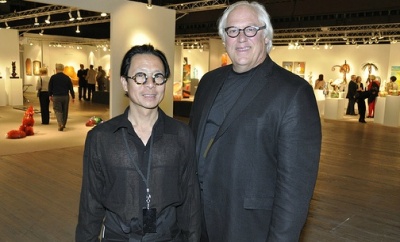 David Ling, the architect who put his mark on the interior of the Park Avenue armory for SOFA New York 2012, pictured with Art Fair Company president Mark Lyman. courtesy: www.sofaexpo.com
David Ling, the architect who put his mark on the interior of the Park Avenue armory for SOFA New York 2012, pictured with Art Fair Company president Mark Lyman. courtesy: www.sofaexpo.com
The organizers of SOFA New York took a cue from the ongoing renovation of the Park Avenue Armory‘s exterior to boldly re-imagine the interior design of their 15-year-old East Coast art fair for the 2012 edition. New York City architect David Ling was invited to remake the main exhibition area and its three aisles of booths.
 Artist Paul Stankard (right) among the fair goers making their way through David Ling’s white fabric entranceway to the exhibition area.
Artist Paul Stankard (right) among the fair goers making their way through David Ling’s white fabric entranceway to the exhibition area.
The result is a cloth-draped tunnel entrance that opens up into an airy expanse with geometric white block lighting suspended high overhead. “I conceived of it as a time machine-like procession,” says Ling in a prepared statement. “This procession leads visitors from the stately, Victorian-era foyer of the Armory through a long, narrow tunnel, tantalizing you with the prospect of an unknown but exciting journey.” Exhibitor booths were rearranged from years past so that veteran showgoers had to seek out their favorite galleries, and the number of dealers was pared back to 42, with the organizers asking not only that exhibitors submit the names of the artists whose work they would be showing for approval, but images as well. There were fewer jewelry or carpet sellers at this year’s event, and the fair had a decidedly more sophisticated look and feel, and yet the buyers, by the second day of the four-day event, were limited if the presence of red dots was any reliable indication.
 John Kiley, Opaque Interior Eclipse, 2012. Blown and cut glass. H 15, W 13, D 13 in. photo: jeff curtis. courtesy: schantz galleries.
John Kiley, Opaque Interior Eclipse, 2012. Blown and cut glass. H 15, W 13, D 13 in. photo: jeff curtis. courtesy: schantz galleries.
One of the few artists generating a lot of collector attention was John Kiley, showing cool geometric blown glass forms with strategic reveals of the complex interior space at Schantz Galleries, which also brought Dan Dailey and Martin Rosol’s work. The selling energy was all in Kiley’s third of the display area, with seven red dots by the end of the second full day of SOFA New York. Kiley assisted Lino Tagliapietra for many years though his work betrays this influence in subtle ways only visible to the most sensitive viewer. The artist told the GLASS Quarterly Hot Sheet that the Italian maestro’s influence was in the complete knowledge of how blown glass behaves, and glimpses of form midway through the process that Kiley filed away for later reference, and which he uses in his own creations. In a 2010 interview with the Hot Sheet, Kiley talked about other influences on his work, chiefly Seattle sculptor George Tsutakawa’s public art.
Dealers remarked that they were seeing more selling energy today, Saturday, and held out hope that the SOFA’s longer run-time (the show will stay open through Monday, April 23rd, to allow museum personnel to visit the show) would ultimately deliver the sales results they were looking for. Regular SOFA New York exhibitor Barbara Silverberg, owner of online gallery Option Art, was impressed with the changes to the 2012 edition of the art fair. “The layout is spectacular,” she told the Hot Sheet. She was impressed with the decision by the show organizers to curate the dealers and winnow down their numbers. And she said she hoped that the careful buyers, such as those who put a pair of tall blown glass botanical forms by Gordon Webster on hold, would be returning to finalize their purchases. “The show this year has fewer dealers who were chosen more selectively, and I think it will have more of an impact on the public not only for this year but for the future.”
IF YOU GO:
SOFA New YorkThrough Monday, April 23rdPark Avenue at 67th StreetNew York CityWebsite:www.sofaexpo.com To take the temperature of SOFA New York 2012, and to provide an idea of what type of work was selling briskly, the GLASS Quarterly Hot Sheet presents an expanded Red Dot Report below, a random sampling of successful sales, including retail prices (which can be discounted significantly by galleries to close a sale).
[gallery columns=“2”]


